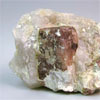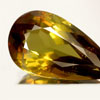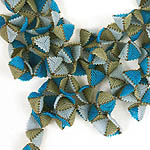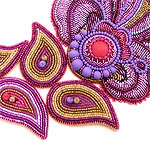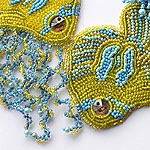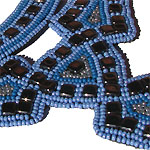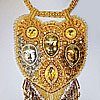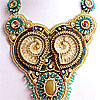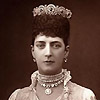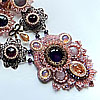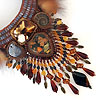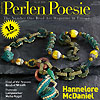May, 2014

From MyLovelyBeads.com TeamSummer is coming! We love summertime because of a hot sun for swimming, fishing, eating outside, and much more! In the last issue before summer of MyLovelyBeads.com newsletter:
Andalusite - gem from Spain
Contact us with any questions at
info@mylovelybeads.com.
Fashion Colorworks. One week to go! Traveling with beads - Patty McCourt Victorian jewelry fact sheet Hooked on gemstones - Irina Chikineva Perlen Poesie Magazine. Issue 21 Upcoming events Best regards,
MyLovelyBeads.com Team |
Andalusite - gem from SpainAndalusite is an aluminum silicate, closely related to both silimanite and kyanite. In fact, all three minerals are polymorphs, which means they share the same chemical composition, but possess different crystal structures. Andalusite is a strikingly beautiful gem, but it is largely unknown to the general public and considered to be one of the lesser-known gem types in the trade. Andalusite colors are typically found yellow, yellow-green, green, brownish red, olive and reddish brown. Andalusite gives a play of different colors because of its strong pleochroism (pleochroism is an optical phenomenon in which a substance appears to be different colors when observed at different angles) along with iolite, kyanite, kunzite, sphene and tanzanite. Andalusite has trichroic pleochroism; when light enters the stone, it is parted into three sections, each containing a portion of the visible spectrum. Andalusite most often occurs translucent to opaque, with transparent gemstone-quality specimens being very rare. For many years, andalusite has primarily been a collector's stone, but it has recently attracted a lot of attention from many jewelry designers and it's becoming increasingly popular. Andalusite possesses a good level of durability and hardness that make it making it suitable for any type of jewelry. The attraction of andalusite is greatly owed to its play of color, which can be seen during changes in its viewing angle. Similar effects are also seen when lightning strikes the gem from different directions. Andalusite is named after the Spanish province Andalusia, where transparent gem-quality crystals were first found in the Ronda Massif near Malaga and described in 1789. Andalusite deposits can be also found in many locations, including Australia, Brazil, Canada, Russia, Sri Lanka, Burma, Madagascar and the USA (California and Colorado). |
||||||||
Fashion Colorworks. One week to go!
Here are the fragments of some first entries we have already received. You can submit your entries for the Fashion Colorworks 2014 Beading Contest in three categories until June 16 (June 15, midnight EST is the deadline). We are looking forward to seeing your amazing bead items in the contest! Read all the details of the contest including how to enter the contest, in the rules.
Fashion Colorworks 2014 rules
|
||||||||
Traveling with beadsPatty McCourt was born in the South American country of Colombia. In 1985 she got married to a geologist from Great Britain and moved to England where she lives in Nottingham with her husband Bill and two lovely daughters. Patty and her husband They have travelled to many countries and lived there, and everywhere Patty has learned local cultures and crafts. While studying at the college in Nottingham she has known beading and fell in love with it. Now Patty is a well-known bead artist and a teacher; we believe it would be pleasure for you to meet her in our newsletter! Patty says, "Ever since I can remember I have loved art and craft and to make things. When I was a child I helped my mom make quilts from fabric samples, I also learned at school in Cali (Colombia) how to crochet squares to create throws. I have painted in acrylics, learned how to craft batik and to make mosaics, as well as silk painting and tapestry weaving! I love cooking and I am an avid book collector. When I went to the university, I wanted to study architecture but was persuaded to take accountancy to support the family business. I felt attracted to beads and beadwork while studying and completing my degree in 3-Dimensional Design at the college in Nottingham. I became obsessed with those pretty little things and the rest as they say is history! I have a diploma in Custom Jewelry Making and in Textile Techniques; and a City and Guilds Teacher Training Certificate. I have taught beadwork in adult educational center for over 8 years and I have used my expertise and creative talents to take beading in many new and different directions... just ask my students! I am passionate and enthusiastic about beadwork in all its forms. I always find inspiration in nature and like looking for natural patterns that are interesting and intricate. I love creative process; it is exciting for me to start researching an idea, looking for textures, shapes, patterns and colors. I normally begin with writing words that will remind me later of my ideas, sometimes it happens in the middle of the night, so I keep a pen and paper next to my bed, and then I sketch and draw my ideas. I also have a room full of craft and beading books and magazines as visual reference in a wide range of languages, Korean, Russian and German to mention a few of the ones I can't understand. I also find inspiration over the Internet in websites, blogs and social networks. I love color and my advice to everyone is that if you see a color combination you like take a photograph of it, it will inspire a piece of jewelry or something like that later. I am a member of The Bead Workers Guild (UK), The Bead Society of Great Britain, The Starman Trend Setters Design Team (USA), The Living Threads Artists Group (UK) and The Beading Clinic. The last one is an exclusive and fun group that I formed to help beaders around Nottingham solve their beading problems and finish their UFOs (UnFinished Objects). We also provide workshops, share ideas, socialize and just have a good time..."
Full article by Patty McCourt
|
||||||||
Victorian jewelry fact sheetMany of us have heard about Victorian style which highlighted "The Era of Queen Victoria". The Victorian era is lengthy, covering the entire reign of its namesake Queen from 1837 to 1901. Women overtook men as the primary jewelry wearers and they wore it in great volume. Decorative and necessary items such as buckles, buttons and fasteners were now designed with the masses in mind. Production of memento, religious and talismanic jewelry was unsurpassed and these items were suddenly a necessity for everyone. In order to understand this wide ranging era of jewelry history it is subdivided into three periods; the Early or Romantic, the Middle or Grand, and the Late Victorian or Aesthetic periods. Early Victorian, romantic jewelry (1837-1850). Themes inspired by the Renaissance and the Middle Ages were everywhere in jewelry design and motifs from nature dominated the period. Bouquets of flowers, branches, leaves, grapes and berries were conspicuously featured in jewelry. Symbolism associated with flowers was prominently in evidence. Serpent motifs were at their apex. Popular since antiquity, snake jewelry served as a bold symbol of wisdom and eternity. Frequently, these designs were delicately and intricately etched into gold. Lockets, cameos and brooches were popular everyday jewelry during the early Victorian era whereas colored gemstones and diamonds were worn during the evening. Mid-Victorian, grand jewelry (1860-1880). The Renaissance and Egyptian revivals were joined by a classical revival of Greek and Etruscan styles along with Scandinavian jewelry. The jewelry enhancement techniques of engraving and chasing were replaced by the revival of ancient techniques to create matte and shiny surfaces, depth and relief were provided by corded wire, filigree and granulation. Because the Grand or Mid-Victorian era corresponded with the Victoria's husband, many jewelry pieces have solemn, grave designs. Known as mourning jewelry, the pieces feature heavy, dark stones. Jet, onyx, amethyst, and garnet are frequently found in jewelry from this period. The jewelry also became especially creative during this period. More colorful designs were born featuring shells, mosaics and colorful gemstones. Late Victorian, aesthetic jewelry (1885-1900). The Aesthetic Period of Victorian jewelry can be defined as one of reaction against previous jewelry periods. Victorians became disillusioned with fashions and furnishings and sought a way out of the conventions of the past, moving toward a time of more refined artistic taste. Fashionable women wanted to achieve the impression that they were a bit naughty or frivolous thus showing the world they were modern. The Gibson girl hairstyle depicted in 1890 in drawings by Charles Dan Gibson portrayed women in this new light. During the Aesthetic period, jewelers used diamonds and feminine, bright gemstones such as sapphire, peridot, and spinel. Star and crescent designs as well as elaborate hat pins were very popular. |
||||||||
Hooked on gemstonesIrina Chikineva from Moscow, Russia, is our another guest today. She started making jewelry when she realized that she couldn't find items in the stores that might have met her aesthetics; and Irina has already been beading for over 5 years. One of the reasons she made such a decision was her inspiration she received from the great beadworks created by the hands of many bead artists. Mainly bead embroidery, Irina's works are real eye candies for all who likes to bead and to wear beads. We're glad to have Irina here today! Irina says, "The hard path of experiments and error (initially I've reworked most of my items, and even cut some ruthlessly), and success led me to understanding of techniques and "sense of materials", the ability to choose elements and compose harmonious, well-balanced pieces. I'm very kind and gentle to my beadworks, I've been thinking about every element for hours. I really love working with gemstones and beads, mixing different materials, creating different textures and experimenting with shapes. Generally, working with materials is my greatest passion. I've got a good collection of gemstones and I fill it all the time; I think it is very convenient when everything is at hand. Sometimes such interesting ideas are born that I want to sit down immediately and start making them live without losing courage and wasting any time running in search of the right materials. Therefore, at every opportunity I buy all that I can come in handy in the future. I like gem shows and exhibitions where I can communicate with other collectors and geologists who can tell a lot about gems. Stones for me are indispensable elements of my jewelry and the rest is just optional to put all elements together. My husband and I have three children and I believe that life is beautiful, and jewelry design is my way to express my positive emotions. I very much appreciate the gift to put my ideas in cute heart gizmos. It gives me the opportunity to travel back in time, creating a replica of the past, to participate in the formation of the present fashion trends and attempts to look into the future, assuming what jewelry will look tomorrow. I draw inspiration from all over. In nature - I just, for example, can't pass by the butterflies calm, I'm studying art and culture of other peoples and countries, and I like visiting art galleries. My inexhaustible source of inspiration is travels, and now I'm working on a series of jewelry "Greek Holiday". Lately I've been involved in various photo projects; photographers taught me to see woman's beauty..."
Full article by Irina Chikineva
|
||||||||
Perlen Poesie Magazine. Issue 21June 10th, 2014 - PERLEN POESIE 21 is coming out! Featuring sensual jewelry - through their densely beaded surfaces they just beg you to touch them. Learn about the Hexagon technique, and fall in love with new and beautiful kinds of beads. And as usual, artists from around the world offer great suggestions in 16 projects. What a beadiful summer it is!
• Intuitive Design
Hannelore McDaniel: Trained in graphic design, she used to make collages out of vintage materials. Today she uses old and new beads as well as small pieces of artwork to produce surprisingly harmonious jewelry. • Multi-Sided Course: Hexagon Stitch - Each bead forms one of the 6 sides - the enhancement of RAW. We'll show you how to keep track! • Dreamy Interconnections Portrait: Meike Nagel - The "Artist of the Torch" explains what math and lampworking have in common. Enjoy her imaginative objects. • Graveside Decorations History: Beaded Wreaths - Customs change over time. Sometimes a window into the past opens, such as this spectacular find from old factory buildings which hadn't been entered in many decades.
Subscribe to Perlen Poesie magazine
|
||||||||
Upcoming events
Less is More: Small Works in a Great Space
May 28 - June 15, 2013
Online gallery of the Less is More Exhibition
Less is More: Small Works in a Great Space (A Mitchell Gallery National Juried Exhibition) - this exhibition of small works, no larger than 8" x 10" x 4", includes pieces of art by artists from across the nation. 235 artists from 34 states submitted 627 works for the juror's consideration, and 269 artworks of 173 artists were selected. All works are for sale and can be viewed in the online gallery. All proceeds benefit the educational programs of the Gallery. 
World of Beads: Celebrating 25 Years June 20 - 22, 2014
Fashion Institute of Technology The World of Beads: Celebrating 25 Years will make The Bead Society of Greater New York the second oldest bead society in the USA in existence, surpassed only by Los Angeles at 30 years. Congratulations members! In program: Juried Exhibit of Award Winning Beadwork; Free Mini-Workshops; Vendors, Demos, Raffles; A Children's Table. Two beadworks by Zoya Gutina were juried into the exhibition and will be showcased there: Art Nouveau Restored Necklace and Mystic Garden Necklace. |
||||||||
Note
If you don't see the newsletter properly formatted please click here:
May Issue
|
||||||||
© 2014 MyLovelyBeads.com All Rights Reserved.
If you do not want receive our newsletter and you wish to remove your email address from our mailing list, please click the following link to unsubscribe.



